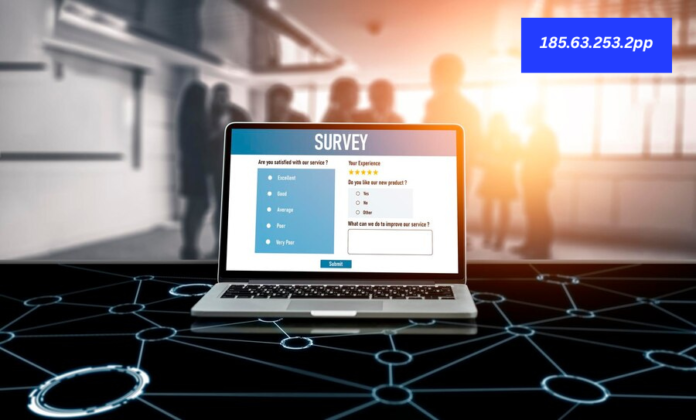In the digital age, IP addresses serve as the backbone of internet communication, allowing devices to connect and exchange data seamlessly. Among the vast range of IP addresses, 185.63.253.2pp stands out as an intriguing example that raises questions about its structure, purpose, and functionality. This article delves into the details of IP addresses, with a special focus on 185.63.253.2pp, explaining its components, potential uses, and common misconceptions. Whether you’re a networking professional, a tech enthusiast, or someone curious about how the internet works, this guide will provide valuable insights into the world of IP addressing.
We will explore the fundamentals of IP addresses, analyze the structure of 185.63.253.2pp, discuss its possible applications, and address frequently asked questions. By the end of this article, you will have a thorough understanding of how IP addresses function and why certain formats, like 185.63.253.2pp, may appear unusual.
What Is an IP Address?
An Internet Protocol (IP) address is a unique numerical identifier assigned to every device connected to a network. It enables devices to locate and communicate with each other, much like a postal address helps deliver mail to the right destination. IP addresses come in two primary versions: IPv4 (Internet Protocol version 4) and IPv6 (Internet Protocol version 6).
IPv4 addresses consist of four sets of numbers separated by periods (e.g., 192.168.1.1), while IPv6 addresses are longer and use hexadecimal notation (e.g., 2001:0db8:85a3:0000:0000:8a2e:0370:7334). The address 185.63.253.2pp appears to follow the IPv4 format but includes an unusual suffix (“pp”), which deviates from standard conventions. This raises questions about whether it is a valid IP address, a typographical error, or part of a specialized naming system.
Breaking Down 185.63.253.2pp
The IP address 185.63.253.2pp seems to combine traditional IPv4 numbering with an alphanumeric extension. Let’s analyze its components:
- 185.63.253.2: This segment follows the standard IPv4 format, where each octet ranges from 0 to 255.
- pp: The letters “pp” at the end are unconventional, as IP addresses typically do not include alphabetic characters in their numerical sequence.
Possible Explanations for the “pp” Suffix
- Typographical Error: The “pp” could be a mistake, possibly intended to be a different character or part of a larger string.
- Internal Naming Convention: Some private networks or proprietary systems may use custom extensions for internal routing or identification.
- Domain or Subdomain Reference: The address might be part of a subdomain (e.g., 2pp.example.com), where “pp” serves as a label rather than an IP component.
- Placeholder or Example: It could be a fictional or example address used in documentation or testing.
Without additional context, it is difficult to determine the exact purpose of 185.63.253.2pp, but it is unlikely to function as a standard public IP address.
How IP Addresses Are Assigned and Managed
IP addresses are distributed by regional internet registries (RIRs) such as ARIN (North America), RIPE NCC (Europe), and APNIC (Asia-Pacific). These organizations allocate blocks of addresses to internet service providers (ISPs) and large enterprises.
Public vs. Private IP Addresses
- Public IP Addresses: Used for devices accessible over the internet (e.g., web servers).
- Private IP Addresses: Reserved for internal networks (e.g., home or office LANs) and not routable on the public internet.
Given that 185.63.253.2pp does not conform to standard IP formats, it is unlikely to be a registered public or private address.
Common Uses of IP Addresses
IP addresses play a crucial role in various networking scenarios, including:
1. Website Hosting
Every website is hosted on a server with a unique IP address. When you type a domain name (e.g., google.com), the Domain Name System (DNS) translates it into an IP address to locate the server.
2. Network Security
IP addresses help in monitoring and filtering traffic. Firewalls and intrusion detection systems use IP data to block malicious activity.
3. Geolocation Services
Companies use IP-based geolocation to customize content, enforce regional restrictions, or detect fraud.
4. Remote Access & VPNs
Virtual Private Networks (VPNs) mask users’ real IP addresses to enhance privacy and bypass geo-blocks.
Potential Issues with Non-Standard IP Formats Like 185.63.253.2pp
If 185.63.253.2pp were used in a real-world application, several problems could arise:
- Connectivity Failures: Standard networking equipment would reject the address due to its invalid format.
- DNS Resolution Errors: The “pp” suffix would cause DNS lookup failures unless treated as part of a domain name.
- Security Risks: Malicious actors might exploit such anomalies in phishing or spoofing attacks.

Frequently Asked Questions (FAQs)
1. Is 185.63.253.2pp a Valid IP Address?
No, 185.63.253.2pp is not a valid IP address because it contains alphabetic characters, which are not permitted in standard IPv4 or IPv6 formats.
2. What Could “pp” Represent in This Context?
The “pp” could be a typo, part of a subdomain, or an internal naming scheme, but it does not comply with official IP address standards.
3. How Do I Troubleshoot an Invalid IP Address?
- Verify for typos.
- Consult network administrators if it’s an internal reference.
4. Can Custom IP Formats Be Used in Private Networks?
Most networks rely on standard IP addressing, but some proprietary systems might use custom identifiers. However, interoperability issues may arise.
5. What Are the Risks of Using Non-Standard IP Addresses?
Non-standard formats can lead to connectivity problems, security vulnerabilities, and compatibility issues with networking devices.
Conclusion
The IP address 185.63.253.2pp presents an interesting case study in networking conventions. While it resembles a traditional IPv4 address, the inclusion of “pp” makes it non-compliant with standard protocols. Understanding IP addressing is essential for troubleshooting network issues, enhancing security, and ensuring seamless connectivity.
Whether you encountered 185.63.253.2pp in an error message, a configuration file, or a discussion, this guide clarifies why it doesn’t fit standard IP conventions. Always double-check IP formats to avoid connectivity problems and consult networking professionals when in doubt.
By grasping the fundamentals of IP addressing, you can navigate the digital world with greater confidence and technical proficiency. If you have further questions about IP addresses or related networking topics, refer to official documentation or seek expert advice.


